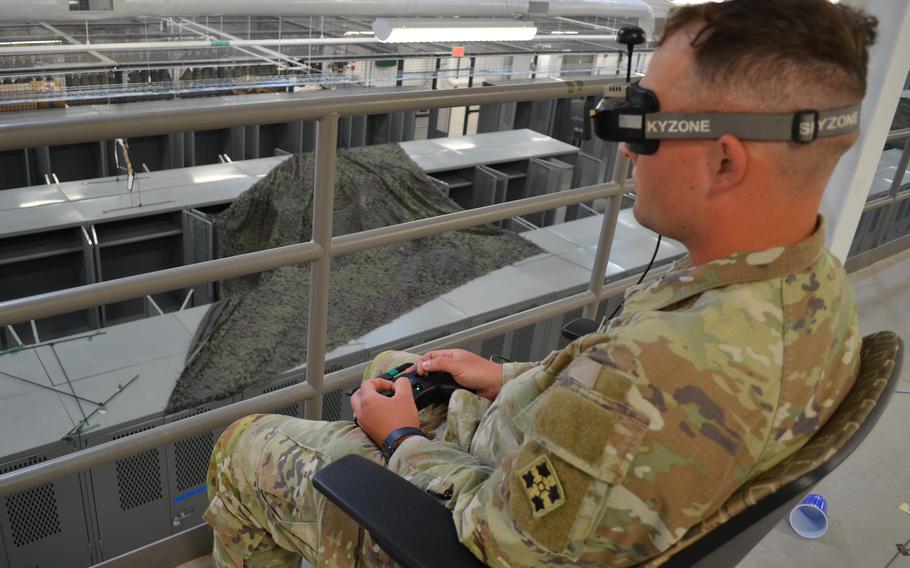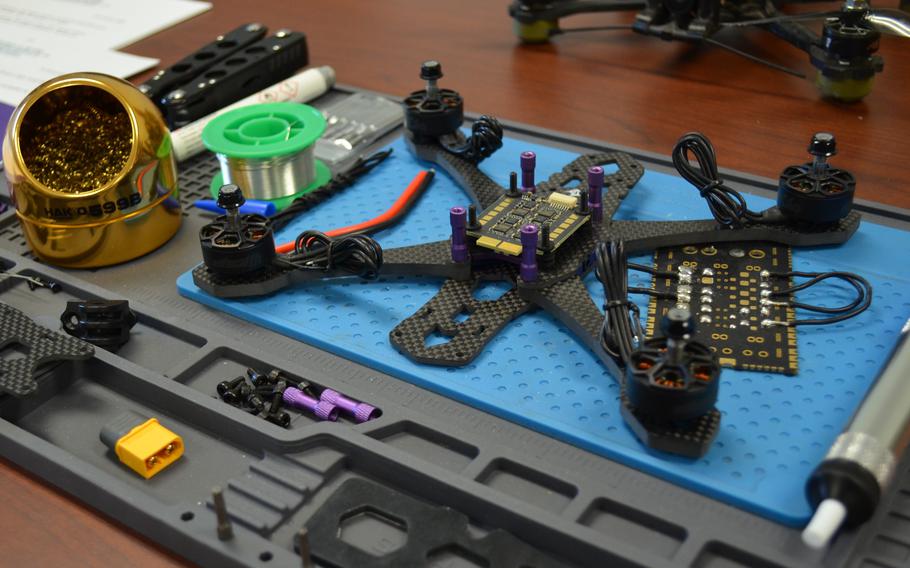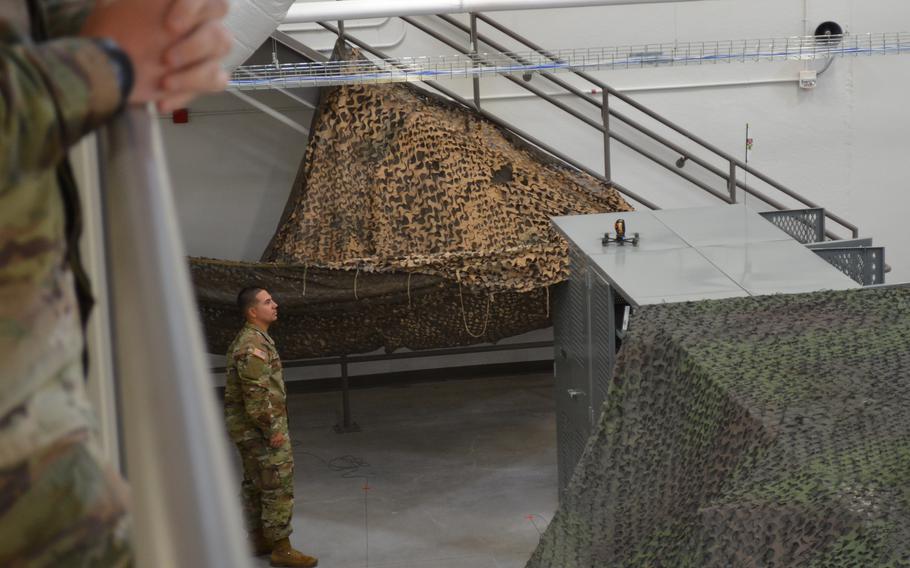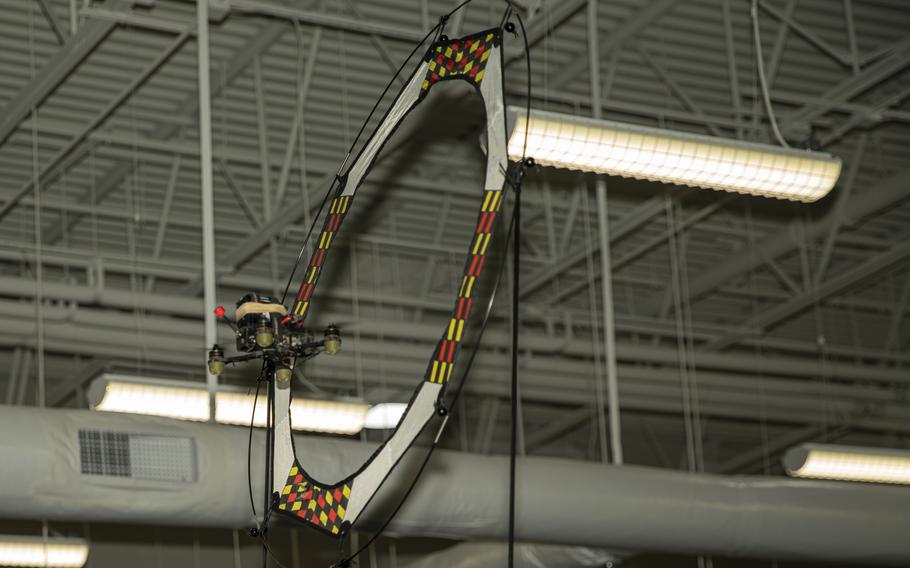
Army Sgt. Wyatt Pickett flies a drone at the Monster Garage at Fort Carson, Colo., on May 16, 2025. (Rose L. Thayer/Stars and Stripes)
FORT CARSON, Colo. — Sgt. 1st Class Jovani Vasquez spent a week learning about the new aircraft that he would fly for the Army — a small, commercially available drone that is cheap enough to break and replace without a lot of paperwork.
To keep the football-sized quadcopter flight-ready and improve his own flying skills, Vasquez scours online forums and YouTube tutorials, he said.
“Then there’s tactical employment. It is a beast in itself,” he said recently during a tour of the 4th Combat Aviation Brigade’s Monster Garage, the home of a platoon-sized unit innovating how the 4th Infantry Division incorporates small, cheap drones among its soldiers. It’s an initiative underway in most Army divisions to keep up with rapidly evolving battlefield technology.
“[Drone flying] started as a hobby, you know, flying in open spaces, clear lines of sight,” Vasquez said. “Now, the [Defense Department] is trying to take those and apply that to where you want to be concealed. You’re completely changing the way that these systems were created.”
In the Monster Garage, a converted pilot locker room at the Army base in Colorado Springs, he and other soldiers practice sending the drone through hoops and under camouflage netting and then landing it safely on a target. In the field, soldiers experiment with the range and capabilities of drones, and the ease at which they can be repaired.
They’ve practiced using the drone as a supply delivery system, for surveillance and as an explosive device. They also tested the limits of where and how the drones can take off. In a video taken earlier this year, the drone — a Litehawk UAS — takes flight from a soldier’s back.
A basic system retails for about $40 on Amazon.

The video monitor of the small drone system used by the Small Unmanned Aerial Systems Innovation and Standardization Platoon in the 4th Infantry Division at Fort Carson, Colo., on May 16, 2025. (Rose L. Thayer/Stars and Stripes)
Established about four months ago, the unit calls itself the Small Unmanned Aerial Systems Innovation and Standardization Platoon, or the Dragonflies. Its twofold mission is to figure out what exactly it can do with these small drones, create standards and then teach the combat units of the division how to incorporate the drones into the work of infantry formations, cavalry scouts and logistics operations.
The work is part of a larger Army initiative to get drones quickly into the hands of all types of soldiers — not just specially trained operators — in response to the ongoing use of drones in conflicts around the world. Ukraine used a fleet of more than 100 relatively cheap drones Sunday to strike four airfields deep inside of Russia, possibly damaging up to 1/3 of Moscow’s strategic bomber fleet, according to The Associated Press.
The following day, Russia launched more than 470 drones against Ukraine in a war that has dragged on for three years.
Divisions across the U.S. Army have stood up platoons to serve as the local experts of unmanned flight with support of the 2nd Battalion, 13th Aviation Regiment at Fort Huachuca, Ariz., which falls under the 1st Aviation Brigade at the Aviation Center of Excellence. The battalion previously trained operators and mechanics for the Shadow Unmanned Aerial System that the Army decommissioned last year. Now the school is training soldiers to go out and fill the operational need of small drone systems and be subject-matter experts for others, said Lt. Col. Kent Monas, the battalion commander.
“Any soldier could be trained to go fly these,” he said. “It’s almost like they’re trained on their M-4 rifle. All soldiers can operate one of these, and we can maximize the amount these systems that are out there.”

Army Sgt. 1st Class Jovani Vasquez watches a drone prepare to launch at the Monster Garage at Fort Carson, Colo., on May 16, 2025. ( Rose L. Thayer/Stars and Stripes)
The Shadow system, which Vasquez operated at the start of his Army career, required access to a runway and needed a launcher system to take flight. It became “too logistically burdensome,” Monas said.
Now the Army is looking at various capabilities instead of investing in one system, he said.
“What they use in Hawaii may not be the same thing that they need to use in Alaska or Europe or down here in Arizona,” Monas said. “Whatever the mission set, it can be adapted for those missions.”
The Army has even created an umbrella acronym to refer to the many small, cheap drone systems it is using across units — purpose built, attritable systems, or PBAS.
Gen. Randy George, the Army’s chief of staff, said the service is taking a bottom-up approach to integrate drones.
“Our soldiers have a really good mindset for innovation,” he said May 19 at the Council on Foreign Relations, a New York-based think tank.
To match that, the Army needs agile funding, George said.
“I think we have to buy things that are modular and open system architecture so that you can put an active protection system and change things out,” he said. “We just really have to change how we’re doing business.”
At Fort Carson, the Dragonflies are not just playing around with new capabilities for drones, they’re also opposing other units during field training so the soldiers know what their enemies can do with a drone.
“We’ve been out there in the field teaching people how to react to small [drones],” said 1st Lt. Nicholas McDonald, the Dragonflies platoon leader. “It’s a very evolving concept, but things like passive air defense, concealing your signature, whether that be physical or [electronic], that’s something we’re trying to teach and integrate as well. … If they’re flying drones overhead, how am I reacting?”
Moving forward, the platoon is focused on procuring more components for drones and different aircraft with more capabilities, such as surveillance and enhanced camera operations, said Chief Warrant Officer 2 Cullen McCauley, the 6th Air Cavalry Squadron, 17th Cavalry Regiment operations officer for unmanned systems.
“What we’re primarily focusing on right now … is a smaller aircraft that anybody can take out of their ruck, launch it and see over the next hill. And then, how close do you have to be to what you want to see to use this thing?” he said.

A small Unmanned Aerial System maneuvers through an obstacle course in the “Monster Garage” on April 23, 2025, at Fort Carson, Colo. (William Rogers/U.S. Army)